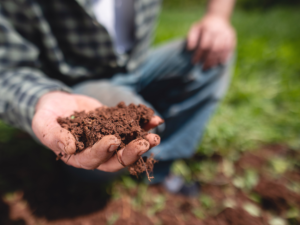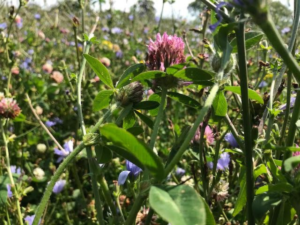My farm is too dry, too wet, it’s too high, too low lying, I have heavy clay, I have sandy soil, what about the high winds and wild winters?
Will regenerative agriculture work on my farm?
I get this question a lot. And it immediately tells me that I haven’t done a good enough job explaining what regenerative agriculture is.
There are several ‘lineages’ of regenerative agriculture, but all of them, to some degree, are true to their agroecological roots and apply living or ecological principles to produce food and fibre – we mimic a natural system. Why? Because natural systems produce high levels of biomass year in and year out with no inputs – they are driven entirely by sunshine and rainfall fed by healthy living soils. There’s a lot to be gained from copying that system!
Nature adapts to every corner of the planet. In the steep mountains of the Himalayas, the flora and flora will look very different to the banks of a river deep in Amazonia. But nature works everywhere is simply adapts to the unique conditions of the site.
If nature works where you are, then regenerative agriculture can work too.

In regenerative agriculture, we are simply taking natural principles and working out how best to apply them – using food and fibre crops – to our unique biome, climate, soil type and level of exposure, rainfall level and fertility.
The best versions of regenerative agriculture then take this a step further and recognise that not only is our environment unique, but our personal circumstances are unique too.
For a farm to be truly regenerative and ‘sustain’ able, it needs to work for the farming family’s social requirements as well as pay the bills.
I see too often now people who are inspired by the results of great regenerative farmers and simply copying their practices. I call this ‘adopting regenerative practices’, and it might – if you are lucky – achieve some improvements in soil health and perhaps productivity.
But really, this is like seeing how well the Himalayan flowers grow in the steep mountains of Nepal, transplanting them into the jungle and hoping they will thrive.
For the best results – like the ones being achieved by the famous regenerative farmers – we need to adopt a truly regenerative system which is a very different process and requires each farmer to work out what their regenerative agriculture system is going to be.
This is what I teach, and we call it the regenerative transition process.
Many farms have inherited a farming system from their parents, are farming to environmental prescriptions or are farming in the way that they were taught at agricultural college. This may have been the right system once upon a time, but is simply carrying on that system and adopting a few regenerative practices really going to get you where you need to be now?
We live in a VUCA world. We are farming in a level of volatility, uncertainty, complexity and ambiguity that no other generation has experienced. Climate change, globalisation, a lack of public value for nutrient-dense home-grown food, pest, disease, wormer resistance, prices below the cost of production, and very uncertain support schemes. It’s rough out there!
If you’re going to manage to navigate these VUCA times successfully, then you need to be the captain of your boat, scanning the horizon and adapting to the weather before it changes. You can’t just set the sails in an Easterly and hope it gets you to your destination!
Adopting regenerative agriculture systems can offer a hopeful solution to many of the issues of modern farming. It can help reduce input costs, make farms more resilient and flexible; it can stabilise productivity whilst reducing input costs, improve the nutrient quality of the food produced, help make plants and livestock more resistant to disease, improve the well-being of the family, increase profitability and so much more.
But these compounding benefits cannot be gained from simply doing a bit of mob grazing or planting a cover crop within an existing conventional system. Don’t get me wrong, these are great steps in the right direction, but don’t change one piece of the system and then declare ‘it’ doesn’t work!

There are several things that are true for a regenerative agriculture system;
- It’s about adopting principles and adapting them to your unique context.
- You can only know your regenerative by measuring the outcomes – you can’t say you are regenerative simply by adopting practices.
- Positive outcomes must be ecological, social and economic if the management is to be truly sustainable.
- Farmers must be systems thinkers and see themselves as part of the ecosystem.
- These systems thinkers can adapt their farming system continually in response to feedback.
- Problems are resolved by looking for the root cause of the issue, not simply treating symptoms.
So finding what ‘it’ is for you takes some time, training and persistence. I have found from working with landholdings with wildly differing contexts that this process has some critical steps.
Learning the principles and shifting your thinking. This generally requires a couple of days of training, and in the process of teaching how complex self-organising systems work, a mindset shift begins to occur – systems thinking starts to develop. This is an essential step that’s often missed if simply copying practices.
Developing your unique social, ecological and economic context. This is a detailed process where there’s quite a lot of homework, and we try and start with a blank canvas as far as possible.
On the environmental side, we look at the; unique biome, ecological history, aspect, elevation, soil type, habitats, important species, infrastructure and problem species and consider what type of farming system might work on this land.
On the social side, we look at the needs and desires of the farming family or estate team, what skills are available, the cultural heritage, the social expectations, the level of involvement of all parties, and so much more.
On the economic side, we look at what farming enterprises are possible and potentially profitable within the social and environmental constraints. How can we build resilience by creating complexity in our enterprises? How can we design a system that uses fewer inputs and consumptive expenses? How can we best allocate resources to get the biggest return on investment towards our contextual goals?

Only when we have drawn the plans can we build the house. Is it a small or big house? Highly insulated and designed for minimal, low-cost living, or a huge family house with a games room and large garden? I couldn’t decide how much stone and cement to buy, what size to make the rooms and what bathroom fitting to choose if I hadn’t decided what type of house I was building.
Similarly, how can you make good decisions about what crops to grow, what livestock breeds to keep or how much water infrastructure you need until you have designed your farming system in detail?
Only when we have developed the context can we move on to the grazing or cropping plans, livestock or crop health plans and design of the baseline monitoring.
Regenerative livestock farm A. It could be a retired couple running an upland site on the west coast of Scotland that includes SSSI Atlantic oak woodland and upland mosaic habitat that’s great for rare waders. They want to keep life simple with no staff and hassle and need easy-to-manage livestock. Their financial needs are fairly modest, but they want to eat their own produce and sell to their local community. A small herd of shetland cattle serve the purpose well; they are 100% grass-fed and outwintered with minimal intervention. The grazing plan is designed to fit the needs of the habitats to ensure that biodiversity is prioritised. The farm makes a small profit because its costs are so low and is supported by environmental payments.
Regenerative livestock farm B. It is a highly productive and profitable 600-cow dairy enterprise in Devon. It’s run by two ambitious, driven brothers and a small dedicated team who want to make their mark in the world. They have invested heavily in water and fencing infrastructure and are achieving impressive carbon sequestration, plant biodiversity, water infiltration and production results. They work hard with multiple moves a day, but the profits make it worthwhile. They still buy some organic cereal feed and house the cows for two months a year but have found a sweet spot between output and inputs that ensure they remain resilient and cattle health is optimal.
Creating the regenerative context and developing your plans is more than simply taking your existing system and adopting some practices to save money while maintaining your output. In my approach, we use regenerative design principles to redesign a system that will prevent problems, reduce inputs, reduce emissions, enhance your unique environment and create the perfect life for your family.
It’s about finding your optimal regenerative system. It’s as unique as a fingerprint.
So will ‘it’ work for you?
Yes, as long as you take the time to design your own regenerative system and continue to adapt and evolve as the circumstances change.
Learn more about our Wilderculture Approach Transition Package
